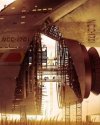This is yet another question, this time on warp nacelles. 
As time progressed and advancements in tech were made, the nacelles seemed to shrink in size, because they became so powerful.
That changed when the Ent - E was introduced in First Contact, again with longer nacelles. And it seemed to continue with some ships…
But why? I see ships with small nacelles(Voyager, Defiant, Protostar, for example) and then ships with larger nacelles(Ent - E onward, Cerritos, some of Picard ships).
Is this just because of design, or something else? Because if shrinking the nacelles was good/better than more elongated ones, why not keep it?

As time progressed and advancements in tech were made, the nacelles seemed to shrink in size, because they became so powerful.
That changed when the Ent - E was introduced in First Contact, again with longer nacelles. And it seemed to continue with some ships…
But why? I see ships with small nacelles(Voyager, Defiant, Protostar, for example) and then ships with larger nacelles(Ent - E onward, Cerritos, some of Picard ships).
Is this just because of design, or something else? Because if shrinking the nacelles was good/better than more elongated ones, why not keep it?

